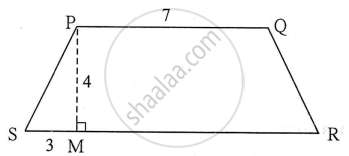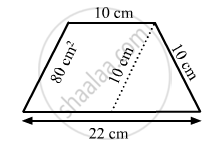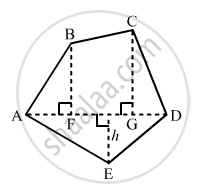Advertisements
Advertisements
Question
☐ PQRS is an isosceles trapezium l(PQ) = 7 cm. seg PM ⊥ seg SR, l(SM) = 3 cm, Distance between two parallel sides is 4 cm, find the area of ☐ PQRS.

Solution

Draw a perpendicular from Q to line MR. Where it meets the line MR, name it point N.
MN = PQ = 7 cm
In ΔPMS,
PM² + SM² = PS²
⇒ 4² + 3² = PS²
⇒ PS² = 16 + 9
⇒ PS² = 25
⇒ PS = 5cm
PQRS is an isosceles trapezium so, PS = QR = 5 cm
PM = QN = 4 cm
So, NR = SM = 3 cm
SR = SM + MN + NR
= 3 + 7 + 3
= 13 cm
Area of trapezium PQRS = `1/2 xx` (sum of parallel sides) × height
=`1/2 xx (7 + 13) xx 4`
= 40 cm²
RELATED QUESTIONS
Find the height of a trapezium, the sum of the lengths of whose bases (parallel sides) is 60 cm and whose area is 600 cm2.
The area of a trapezium is 1586 cm2 and the distance between the parallel sides is 26 cm. If one of the parallel sides is 38 cm, find the other.
In Fig. 20.38, a parallelogram is drawn in a trapezium, the area of the parallelogram is 80 cm2, find the area of the trapezium.
Find the area of the pentagon shown in fig. 20.48, if AD = 10 cm, AG = 8 cm, AH = 6 cm, AF = 5 cm, BF = 5 cm, CG = 7 cm and EH = 3 cm.
Find the area of the trapezium ABCD in which AB || DC, AB = 18 cm, ∠B = ∠C = 90°, CD = 12 cm and AD = 10 cm.
Find the missing values.
| Height 'h' | Parallel side 'a` | Parallel side 'b` | Area |
| 13 cm | 28 cm | 492 sq.cm |
Find the area of a trapezium whose parallel sides are 24 cm and 20 cm and the distance between them is 15 cm
The area of a trapezium is 180 sq.cm and its height is 9 cm. If one of the parallel sides is longer than the other by 6 cm. Find the length of the parallel sides.
The area of the trapezium, if the parallel sides are measuring 8 cm and 10 cm and the height 5 cm is
The area of a trapezium become 4 times if its height gets doubled.
